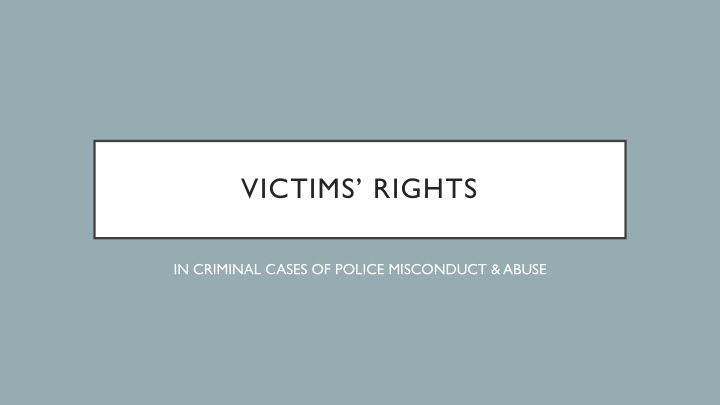



VICTIMS’ RIGHTS IN CRIMINAL CASES OF POLICE MISCONDUCT & ABUSE
FINAL REPORT OF PRESIDENT’S TASK FORCE ON VICTIMS OF CRIME (1982) Somewhere along the way, the U.S. criminal justice system had become “appallingly out of balance,” “serv[ing] lawyers and judges and defendants, [while] treating the victim with institutionalized disinterest.”
HISTORY OF CRIME VICTIMS’ RIGHTS IN CALIFORNIA • 1965: The first crime victim compensation program is established in California. • 1972: Bay Area Women Against Rape in San Francisco, California established, one of the nation’s first three victim assistance programs. • 1976: Fresno County’s Chief Probation Officer creates the first victim impact statement to provide the sentencing court with an objective inventory of victim injuries and losses. • 1982 : California becomes the first state to establish a constitutional right to victim restitution . • 2008 : Ballot initiative creating Crime Victims’ Bill of Rights approved by California voters.
DEFINITION OF CRIME VICTIM (IN CALIFORNIA) A person who suffers direct or threatened physical, psychological, or financial harm as a result of the commission or attempted commission of a crime or delinquent act. Cal. Const. art. I, § 28 (e).
Crime Victims’ Rights under the California Constitution Right Phase (1) Right to be treated fairly and be free from intimidation, harassment and abuse Throughout criminal justice process (2) Right to be protected from defendant Throughout criminal justice process (3) Right to have the safety of the victim considered in setting conditions of release Arraignment (4) Right to prevent disclosure of confidential information Pre-Arraignment (5) Right to refuse an interview by defendant Pre-Arraignment (6) Right to notice of defendant’s arrest and reasonable opportunity to confer with Pre-charge prosecutor (7) Right to reasonable notice of proceedings and to be present Pre-Arraignment (8) Right to be heard at certain proceedings Arraignment (9) Right to a speedy trial and prompt conclusion of the case Trial (10) Right to provide information to probation officer Sentencing (11) Right to receive a copy of the probation report Sentencing (12) Right to notice of conviction and the time and place of sentencing Sentencing (13) Right to restitution Post-conviction (14) Right to prompt return of property Trial (15) Right to participate in the parole process Sentencing (16) Right to have the safety of the victim considered in parole decisions Sentencing (17) Right to be informed of the rights of the victim Pre-charge
Crime Victims’ Rights under Federal Law Right Timing (1) Right to be reasonably protected from accused Throughout criminal justice process (2) Right to reasonable, accurate and timely notice of proceedings, Arraignment parole or escape of the accused (3) Right not to be excluded from public court proceedings Arraignment (4) Right to be reasonably heard at public proceeding (release, plea, Arraignment sentencing, or parole) (5) Right to confer with the government attorney Pre-charge (6) Right to full and timely restitution Post-conviction (7) Right to proceedings free from unreasonable delay Throughout criminal justice process (8) Right to be treated with fairness and respect for the victim’s Throughout criminal justice process dignity and privacy (9) Right to be timely informed of plea bargain or deferred Pre-trial prosecution agreement (10) Right to be informed of the rights under this section and [related Pre-charge services] and given contact information
CALIFORNIA VICTIM COMPENSATION PROGRAM
WHO ARE THE VICTIMS OF CRIMES? • 1 in 5 Californians have been a victim of crime in the last five years. Half of these were a victim of a violent crime. • 2 in 3 of these crime victims have been victims of multiple crime in the past five years. • African Americans and Latinos are more likely to have been victims of three or more crimes in the past five years. • Victims of violent crime are more likely to be low-income, young (especially under 30), and Latino or African American. Study by Californians for Safety and Justice (2013)
ACCESS TO RIGHTS AND SERVICES • Only 20% of crime victims were aware of victim’s restitution funds. • Only 4% of victims’ needs were addressed by the current victim services system. • Ethnic and racial minorities had the highest amount of unmet needs. National Institute of Justice Study (2017)
ELIGIBILITY - RIGHTS A person who suffers direct or threatened physical, psychological, or financial harm as a result of the commission or attempted commission of a crime or delinquent act. The term “victim” does not include a person in custody for an offense. Cal. Const. art. I, § 28 (e).
ELIGIBILITY - SERVICES • Generally, cooperate with law enforcement during the investigation and prosecution of the crime. • Not have been involved in or committed a felony in the events leading to the crime. • A person may not be granted compensation until they have been released from a correctional institution; discharged from parole, probation, or post- release community supervision for a violent felony.
Recommend
More recommend